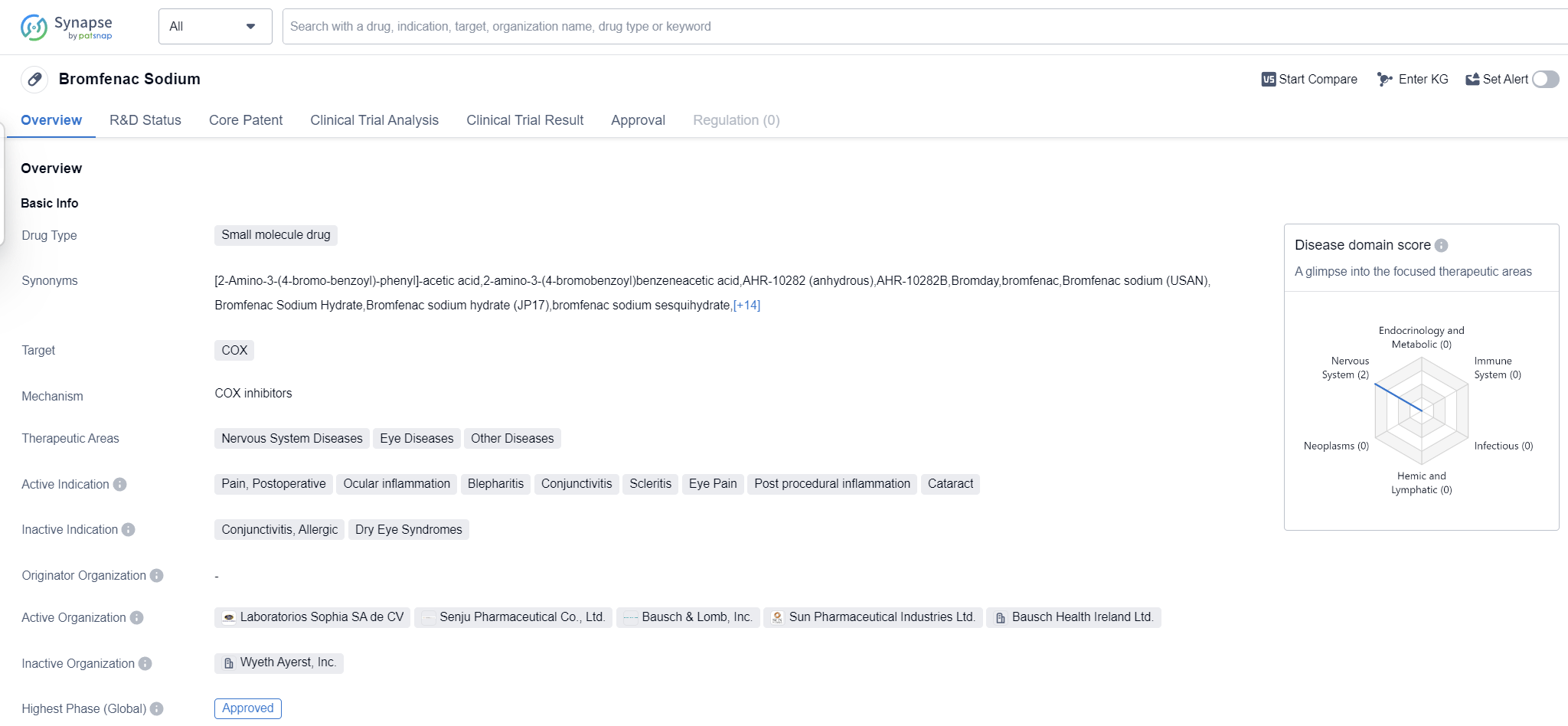Unleashing the Power of bromfenac sodium: A Comprehensive Review on R&D Breakthroughs, Action Mechanisms, and Drug Target
Bromfenac sodium's R&D Progress
Bromfenac Sodium is a small molecule drug that belongs to the class of nonsteroidal anti-inflammatory drugs (NSAIDs). It primarily targets the enzyme cyclooxygenase (COX), which is involved in the production of prostaglandins, substances that play a role in inflammation and pain.
This drug has been approved for use in various therapeutic areas, including Nervous System Diseases, Eye Diseases, and Other Diseases. It is specifically indicated for the treatment of pain and postoperative inflammation, as well as ocular inflammation associated with conditions such as blepharitis, conjunctivitis, scleritis, and cataract. It is also used to alleviate eye pain and post-procedural inflammation.
Bromfenac Sodium has reached the highest phase of development which is approved globally. Its first approval was granted in the United States in July 1997, making it available for use in patients in that country.
As a small molecule drug, Bromfenac Sodium is designed to be easily absorbed and distributed throughout the body. By targeting COX, it inhibits the production of prostaglandins, thereby reducing inflammation and relieving pain. This mechanism of action makes it an effective treatment option for various conditions affecting the nervous system and the eyes.
The approval of Bromfenac Sodium in multiple countries and its long history of use since 1997 indicate its established safety and efficacy profile. It has been widely prescribed by healthcare professionals to manage pain and inflammation associated with various eye diseases and surgical procedures.
👇Please click on the image below to directly access the latest data (R&D Status | Core Patent | Clinical Trial | Approval status in Global countries) of this drug.
Mechanism of Action for bromfenac sodium: COX inhibitors
COX inhibitors, also known as cyclooxygenase inhibitors, are a class of drugs that work by inhibiting the activity of the enzyme cyclooxygenase (COX). COX is responsible for the production of prostaglandins, which are hormone-like substances involved in inflammation, pain, and fever. By blocking COX, COX inhibitors reduce the production of prostaglandins, thereby alleviating pain, reducing inflammation, and lowering fever.
From a biomedical perspective, COX inhibitors are commonly used in the treatment of various conditions such as arthritis, menstrual cramps, and acute pain. They can be classified into two main types: COX-1 inhibitors and COX-2 inhibitors. COX-1 inhibitors block both COX-1 and COX-2 enzymes and are associated with a higher risk of gastrointestinal side effects. On the other hand, COX-2 inhibitors selectively target the COX-2 enzyme and are often preferred for their reduced gastrointestinal toxicity.
It is important to note that the use of COX inhibitors should be done under medical supervision, as they can have potential side effects, including gastrointestinal ulcers, kidney problems, and an increased risk of cardiovascular events. Additionally, certain individuals, such as those with a history of allergies or asthma, may be more prone to adverse reactions to COX inhibitors.
In summary, COX inhibitors are drugs that inhibit the activity of the enzyme cyclooxygenase, reducing the production of prostaglandins and providing relief from pain, inflammation, and fever. They are commonly used in the treatment of various conditions and can be classified into COX-1 inhibitors and COX-2 inhibitors. However, their use should be carefully monitored due to potential side effects and individual considerations.
Drug Target R&D Trends for bromfenac sodium
COX, or cyclooxygenase, is an enzyme that plays a crucial role in the human body's inflammatory response. It is responsible for the production of prostaglandins, which are hormone-like substances involved in various physiological processes. COX exists in two isoforms, COX-1 and COX-2. COX-1 is constitutively expressed and involved in maintaining normal bodily functions, such as protecting the stomach lining and regulating blood clotting. On the other hand, COX-2 is induced during inflammation and is primarily responsible for the production of prostaglandins that cause pain, fever, and swelling. Understanding the role of COX has led to the development of drugs called COX inhibitors, which are used to manage pain, inflammation, and other related conditions.
According to Patsnap Synapse, as of 13 Sep 2023, there are a total of 598 COX drugs worldwide, from 597 organizations, covering 312 indications, and conducting 8106 clinical trials.
The analysis of the target COX reveals a competitive landscape with multiple companies actively developing drugs. GSK Plc, Viatris Inc., and Pfizer Inc. are the companies growing the fastest, with a significant number of drugs in the approved phase. The most common indications for these drugs are pain, common cold, and rheumatoid arthritis. Small molecule drugs are the most rapidly progressing drug type, indicating a focus on developing these types of drugs. China, the United States, and Japan are the countries/locations with the highest development progress, with China showing notable progress in both approved and preclinical drugs. Overall, the target COX presents a competitive landscape with a focus on pain-related indications and small molecule drugs, with China emerging as a significant player in drug development.
👇Please click on the picture link below for free registration or log in directly if you have a freemium account, you can browse the latest research progress on drugs, indications, organizations, clinical trials, clinical results, and drug patents related to this target
Conclusion
In summary, Bromfenac Sodium is a small molecule drug that targets COX and is approved for use in treating pain, postoperative inflammation, and various ocular inflammatory conditions. Its approval in the United States in 1997 and subsequent approvals in other countries highlight its established track record in the pharmaceutical industry. This drug plays a crucial role in the management of nervous system diseases, eye diseases, and other related conditions.






